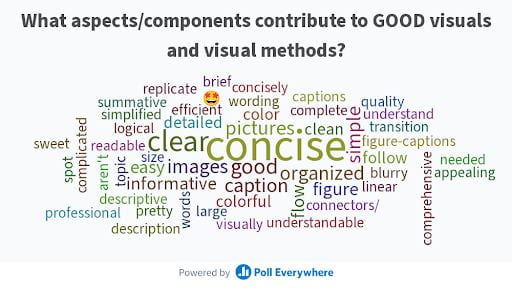Using Poll Everywhere Teams for Collaborative Peer Feedback, E-Journals and Discussion Starters
In Part 3 of this blog series, we share the perspectives of Jordan Mohr, Deborah Lichti, Alenka Hlousek-Radojcic and Jacqueline Fajardo. These four educators are a team of studio preceptors and professors from the Interdisciplinary Science Learning Laboratories in the College of Arts & Sciences. As you read along in Part 3, imagine you’re working with a group of instructors to collect student feedback in a unified manner. Do you…
- each use your own questions?
- collect data independently and then compare?
- use Poll Everywhere teams to coordinate data collection using the same set of questions and easily report on data collected by all presenters on the team?
If you chose A or B, this article will help you understand how Poll Everywhere allows for group data collection and analysis, while also providing alternatives for e-journaling and sparking class discussion.
If you chose C, Poll Everywhere should be helping to meet your needs for collaborating with peers to collect student feedback. The Poll Everywhere team in IT Academic Technology Services is available for those who want to further explore the tool.
Using Poll Everywhere Teams for Collaborative Peer Feedback, E-Journals and Discussion Starters
At a glance
| Featured faculty | Preceptors Jordan Mohr and Deborah Lichti and professors, Alenka Hlousek-Radojcic and Jacqueline Fajardo, Interdisciplinary Science Learning Laboratories |
| Classes sizes | Ranges from 40-70 students |
| Class format | Problem-based learning, laboratory |
| Favorite Poll Everywhere activity | Teams, Clickable Image, Word Cloud |
The teaching team has developed a collaborative way to use Poll Everywhere to have students share feedback on various aspects of the course and use this feedback to inform their teaching and recalibrate if students are not grasping the course material. This Poll Everywhere team, composed of studio preceptors, Jordan Mohr and Deborah Lichti and professors, Alenka Hlousek-Radojcic and Jacqueline Fajardo uses a variety of question types. Collectively, they use multiple choice to gauge student understanding and to learn where students are in their learning process, Q&A upvoting to explore what concepts students might be struggling with, and open-ended and survey question types as discussion starters. In addition, this team of faculty has come up with a unique way to use Poll Everywhere to centralize their student attendance for contact tracing purposes. More specifically, the team has developed a poll with a clickable image question type that allows students to mark where they sit in class. This group of instructors absolutely love Poll Everywhere because they share polls and “feed off of one another, they get inspired to try different things based on what each other is doing.”
Word Cloud questions to collect student feedback


In chemistry lectures, Professor Fajardo uses Poll Everywhere surveys in such a way that students can carry out their exploration of a topic in a manner that is group-paced. The teaching team and the students alike are able to monitor their progression through the series of questions via visualizable progress bars that are updated in real time. During the lab studio sessions, preceptors Dr. Mohr and Dr. Lichti use Poll Everywhere to facilitate students’ development of questions about class-derived data sets and their evaluation, to enhance their ability to draw reasonable conclusions based on the data. She shared that this “allows her to move away from static to more dynamic teaching.” Similar to Associate Professor Rudolphi, Professor Alenka Hlousek-Radojcic develops authentic assessments to prevent the students from simply Googling answers to questions. She’s also able to leverage Poll Everywhere to introduce new concepts and topics in the course. She utilizes heat map and clickable image question types with system modes, diagrams, and cartoons in her polling activities.
Clickable Image questions to Gauge Learning Mastery


There are many unique approaches to using Poll Everywhere at the University of Delaware. Regardless of approach or discipline, we have commonly found that incorporating Poll Everywhere helps instructors to improve student engagement, deliver authentic assessment, and gauge learning mastery. Our hope is that the strategies presented in this blog series will provide inspiration for how Poll Everywhere may be used in your course.
This is the final article in this series. Click here for (1) Gamifying Formative Assessment to Increase Engagement and and (2) Fostering Critical Thinking for Licensure Exam Preparation.
If you’d like assistance implementing any of these approaches, or if you’d like to brainstorm an approach unique to your course and discipline, we’d be happy to help. Contact us at udpolling@udel.edu to schedule a consultation or visit the Poll Everywhere at UD website.
